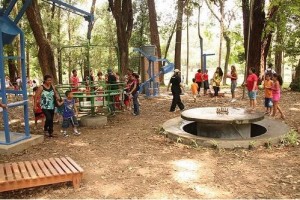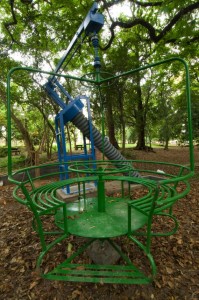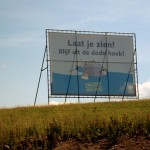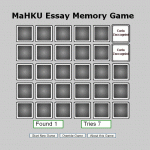The importance of being earnest [2] : went boating on the river Lek a couple…
Zaccagnini’s Playground ‘made for the curious’.
Yes! I found another playground designed by an artist: Carla Zaccagnini’s “Reação em cadeia com efeito variável ” (Chain Reaction with Variable Effect), exhibited at the Sao Paulo Biennale in 2008.
It is a hydraulic and mechanical system driven by the simultaneous use of playground rides, made in collaboration with Alexandre Canônico; technical development: Daniel Dias Ferreira; assistant: Gregório Rocha; advisor: Lauro Inoue; production management: Paulo Masson. Riding the playground rides sets the jets of the fountain in motion.
I quote from the site of the San Paulo biennale:
Thais Rivitti: How was the conception of this work?
The idea for this work came from an invitation to participate of an exhibition on design and politics curated by Kiki Mazzuchelli. As it turned out, I ended up working on something else with Nicolás Robbio; and that project – a swing with four seats that could only be used when all of the seats were occupied – still hasn’t left the drawing board. But it was while thinking about its mechanism that Alexandre Canônico suggested a swing with just one seat that could hold several people and would only work if there was a certain weight on it, and had to be used by, say, four people. In the course of this conversation, about a year ago, we had the idea – which seemed impossible – to build a playground with rides that unlocked one another, forming a single mechanical system of unusual causes and effects. I don’t remember when the fountain came into the picture, but it was the grand finale of the chain of actions: a constant drawing, but transparent and impermanent, epic and innocuous at the same time. It was while talking to Paulo Masson, when the project was already underway, that we discarded the idea of the chain of unlocking rides and came up with this hydraulic system set in action by the use of the rides.
Thais Rivitti: Conspiração [Conspiracy] (working title) – in addition to needing a whole team to be structured, needs to make a pact with the audience in order to be fully realized. What is the role of “others” in your works?
Carla Zaccagnini: Co-authorship is an almost permanent strategy in my work. On the one hand, it is a way of ensuring a distance between what I imagine initially and the final work, of accepting the artist’s lack of control and making the work surprise me. On the other, it is a strategy that poses a question about the definition of art and the role of the artist. In other words, if we can’t say that an artist is one who creates an image or who has the technical skill that defines the realization of an idea and its visuality, and also that what he / she produces is art. Where is the center of this uncertain, flexible terrain that circumscribes the definition of art and redesigns each new work? I don’t know if the pact with the audience you mention is conceptually related to the issue of authorship. I think it has to do with a different issue, equally as relevant in art history: reception. But my position as regards these two aspects of the work of art certainly has something in common: shared responsibility.
Rivitti: At a time when there is some debate about the spectacularization of exhibitions and when the 28th Bienal de São Paulo is seeking to rethink itself and forge new paths, your work – a playground – takes on a certain air of irony. In a way, it is as if the work were making fun of the discourse about spectacularization by presenting a fun idea that is common, trivial, and far removed from fireworks displays.
 Zaccagnini: I am an ironic person, but not cynical or skeptical. Perhaps the playground does have a certain irony, but more than that there is a trust in the possibility of making content understandable by means that aren’t necessarily intellectual or reflexive. You can, of course, trace the history of this work by looking to Duchamp’s The Large Glass, to relational aesthetics, to the notion of formulated participation in Brazilian neo-concretism. But there are other readings of the work that have to do with, for example, the role of the individual in a system of interdependent relations, and which don’t require any understanding of artistic debates at all. For some time now I have been insisting that my work isn’t made for experts, but for the curious. The shifting of the work from inside the Pavilhão das Indústrias* to the open area of Ibirapuera Park is interesting.
Zaccagnini: I am an ironic person, but not cynical or skeptical. Perhaps the playground does have a certain irony, but more than that there is a trust in the possibility of making content understandable by means that aren’t necessarily intellectual or reflexive. You can, of course, trace the history of this work by looking to Duchamp’s The Large Glass, to relational aesthetics, to the notion of formulated participation in Brazilian neo-concretism. But there are other readings of the work that have to do with, for example, the role of the individual in a system of interdependent relations, and which don’t require any understanding of artistic debates at all. For some time now I have been insisting that my work isn’t made for experts, but for the curious. The shifting of the work from inside the Pavilhão das Indústrias* to the open area of Ibirapuera Park is interesting.
* Original name of the pavilion that houses the Bienal de São Paulo.
 I had a look at Zaccagnini’s bio and some other works she’s done. One of the works I really like is ‘jogo transparente’ . It is made up of a transparent deck of cards, a table and two chairs.. The work was first presented at the exhibition ‘This is not a Love Song’ (Galeria Vermelho, Sao Paulo, 2006). Quote from Leon de la Barra’s blog: ” I really like the idea of it being in such different contexts, being read in these different ways. What I like about it is that it is a very simple thing, a very small change into something we all know that obliges us to rethink our strategies and our position. Games are the social spaces in which rules become more evident. Here the rules are not changed, you can play the same games, but the possibility of bluffing is taken away. So what happens to a game when you cannot hide what you have anymore? In this exhibition, I am more interested in the tense situation of you knowing each other’s cards, you seeing the card you need in your rival’s hands reciprocally, and at the same time knowing that you probably won’t have it, even it being so close.”
I had a look at Zaccagnini’s bio and some other works she’s done. One of the works I really like is ‘jogo transparente’ . It is made up of a transparent deck of cards, a table and two chairs.. The work was first presented at the exhibition ‘This is not a Love Song’ (Galeria Vermelho, Sao Paulo, 2006). Quote from Leon de la Barra’s blog: ” I really like the idea of it being in such different contexts, being read in these different ways. What I like about it is that it is a very simple thing, a very small change into something we all know that obliges us to rethink our strategies and our position. Games are the social spaces in which rules become more evident. Here the rules are not changed, you can play the same games, but the possibility of bluffing is taken away. So what happens to a game when you cannot hide what you have anymore? In this exhibition, I am more interested in the tense situation of you knowing each other’s cards, you seeing the card you need in your rival’s hands reciprocally, and at the same time knowing that you probably won’t have it, even it being so close.”
As a rule, Zaccagnini’s work offers participants/viewers the opportunity to reflect on structures of knowledge, on how knowledge is developed and stored in the mind . Her work is a point of departure for participants, inviting them to be active constituents – players even – within the playing field she delimits. She proposes to deconstruct and show the mechanism of how we view the world, how our mental processes and our bodies move through space, mutually influencing and delimiting one another.
| « Meschac Gaba’s Salle de Jeux | <-- previous post | next post --> | How to be logico-philosophic » |
|---|








